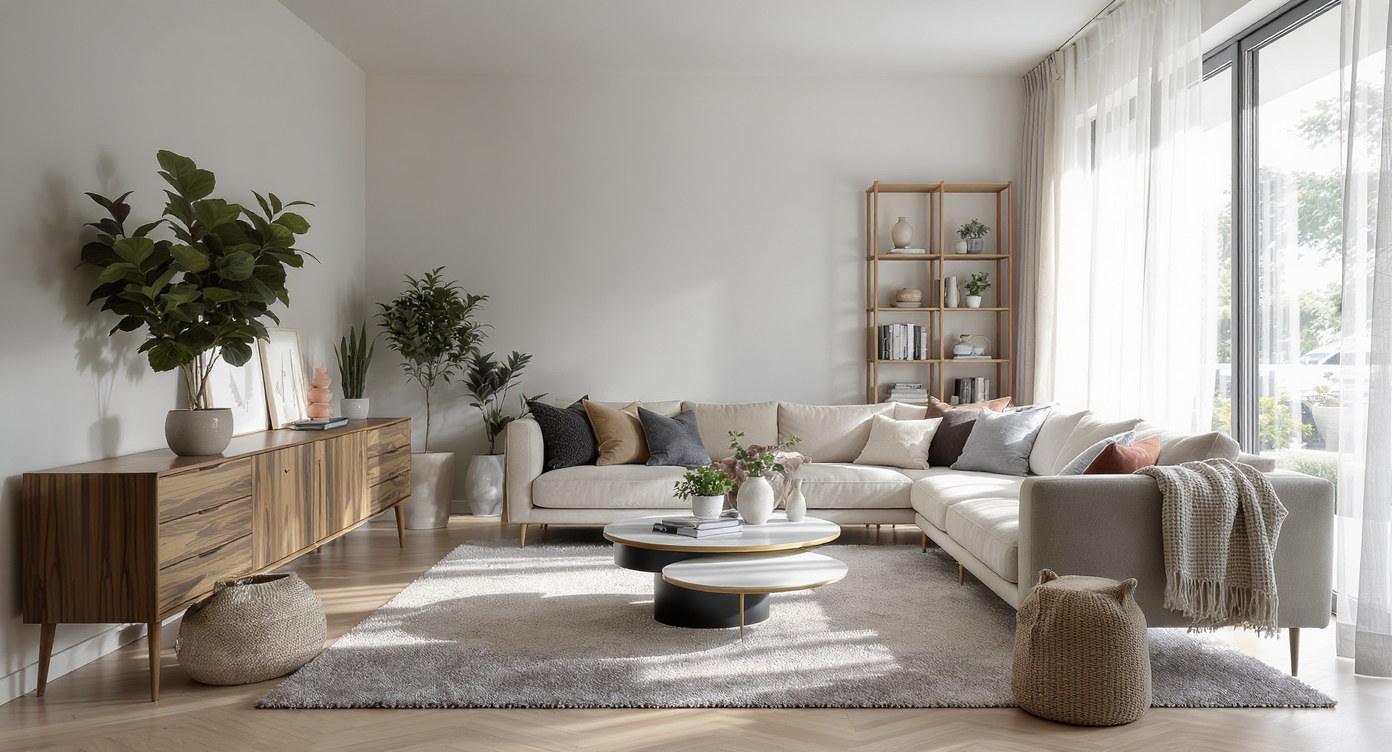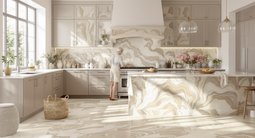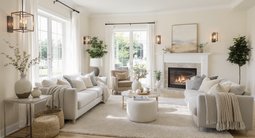TL;DR
Some 2025 design trends—fast furniture, overused cool grays, high-contrast accent walls—deliver quick dopamine but little longevity. Choose warmer palettes, authentic materials, and tone-on-tone moves you can live with, then pressure-test ideas in your own photos using ReimagineHome.ai for realistic room makeovers in seconds.
Why Fast-Fading Interior Design Trends Matter Right Now

Test design trends with realistic previews to avoid costly disappointments in daily living.
Fast-fading design trends matter because they look great on social but often disappoint in daily life. The safest approach is to test any interior design style with realistic previews before you buy paint or furniture. At a glance - Fast furniture ages quickly; invest in fewer, better staples and rotate textiles for modern decor updates. - Overusing cool neutrals flattens a room; switch to warm neutrals with layered woods and contrast. - Loud accent walls date quickly; try full-wrap paint, wallpapered ceilings, or color-drenched built-ins. - Faux finishes feel thin over time; choose authentic wood, stone, or quality veneers for longevity. - Color blocking on cabinetry is peaking; opt for tone-on-tone palettes that calm busy kitchens. - Highly niche aesthetics (dark academia, cottagecore, mob-wife glam) can box you in; blend influences for durability. - Fantasy motifs (glitter, celestial, mushroom everything) work best in small doses. Early CTA: See how these choices look in your space using one photo at ReimagineHome.ai: https://www.reimaginehome.ai/?utm_source=blog
What’s Driving the Boom-and-Bust Cycle (and How to Outsmart It)

Spot fast-fading design trends and learn how to outsmart the boom-and-bust cycle in interiors.
AI layout tools can generate style variations in under 10 seconds, which accelerates how quickly looks go viral—and burn out. That pace can push homeowners into impulsive buys that don’t suit their floor plans, light, or lifestyle. Here’s what’s really driving the churn: - Identity-led aesthetics: Niche labels are fun shortcuts, but real homes evolve through seasons, moves, and kids. Locking into one micro-style makes normal updates feel like total overhauls. - Low-friction shopping: One-click checkouts make fast furniture irresistible, but the pilling, wobbling, and warping show up right when the return window closes. - Algorithmic sameness: Endless grids of the same gray sectional and arched mirror look soothing online, but in person the space can feel flat and overlit. - Renovation fatigue: Big changes are expensive; small, high-impact updates (paint, rugs, drapery, art) stretch budgets—and style—farther. How to outsmart it: - Pressure-test trends with photo-real previews. A 60-second room makeover in your actual space will tell you more than a week of mood boards. - Prioritize permanence wisely: Floors, tile, and built-ins should be timeless; textiles and paint can flex with trends. - Mix global interior design style inspiration—Scandi warmth with Japandi lines, Soft Boho textures with Modern minimalism—so the space reads personal, not copy-paste.
Anecdote
In a compact condo, a client swapped a trendy checkerboard accent wall for a full-wrap clay paint and color-drenched bookshelf. The same art looked elevated, the room felt larger, and the styling pieces—linen pillows, a striped throw—finally clicked. No new sofa required.
How These Trends Look in Real Homes—And What to Do Instead

Smarter design alternatives bring harmony and warmth over fleeting, overpowering trends.
Most living rooms read best with a 60-30-10 palette, which keeps neutrals from feeling flat while giving color a defined role. Use that to pivot from risky trends to enduring choices. 1) Fast furniture → Fewer, better - Instead of the viral boucle chair that sheds, try a kiln-dried wood frame sofa with performance fabric; swap pillows seasonally for modern decor hits. - Longevity check: Touch the underside seams, scan weight specs, and look for repairable parts. 2) Overused cool grays → Warm neutrals with contrast - Trade icy gray walls for mushroom, taupe, or putty; add walnut, oak, or rift-sawn ash for depth. Brass, iron, and matte black hardware add deliberate punctuation. - In practice: A putty wall, charcoal linen drapes, and a honeyed oak sideboard look calm—not bland. 3) Loud, unplanned accent walls → Full-wrap color or color-drenched built-ins - Paint all four walls a softened hue, or take cabinetry, trim, and doors in the same shade for unity. Wallpaper your fifth wall (the ceiling) for quiet drama. 4) Faux finishes → Authentic materials (or quality veneers) - Real stone, solid wood, and limewash age gracefully. If the budget’s tight, choose thick veneers, porcelain that embraces its identity, or microcement with honest texture. 5) Color-blocked kitchens → Tone-on-tone cabinetry - Slightly varied shades of one color read architectural and serene. Think clay on lowers, 10% lighter clay on uppers, with stone that shares the undertone. 6) Hyper-niche styles → Layered, livable blends - Borrow Japandi’s low, clean lines; add Scandinavian pale woods and Soft Boho textiles. Let one statement piece carry the mood, not the whole room. 7) Fantasy motifs everywhere → Edit to accents - Keep the celestial wallpaper in a powder bath or the mushroom lamp on a nightstand. When the mood shifts, it’s an easy swap. Common homeowner question: “Will this feel boring?” Balance texture (boucle, wool, linen), tone (light to dark), and shape (rounded edges with crisp lines) so the room feels curated, not cautious.
Modern Tools That Help You Explore This Style (and Why ReimagineHome.ai Wins)

Modern AI tools let you preview design styles instantly for confident home restyling.
Photo-to-redesign AI can restyle a room from one image without measurements, which makes trying trending interior design styles 2025 safer and faster. Toolscape, simplified: - Mood boards: Great for vibe-setting, but they rarely reflect your exact light, scale, or sightlines. - Floor plan and 3D walkthrough tools: Powerful for remodels; slower for quick style trials and often require measurements. - Style recommendation engines: Helpful for discovery, but inspiration still needs to map to your actual room. - Virtual staging tools: Useful for listings, less so for nuanced material and color testing. Why ReimagineHome.ai stands out for accuracy and speed: - Upload one photo → get decor suggestions in realistic renders that consider your existing architecture. - AI restyle from one photo, no measurements: See multiple directions (Scandinavian, Japandi, Soft Boho, Minimalist) in seconds. - Paint color and furniture combo AI suggestions: Test tone-on-tone cabinetry, warm neutrals, or color-drenched built-ins before you buy. - Tools with large furniture catalogs: Explore layouts and finishes that feel shoppable—not generic. Explore more on the ReimagineHome design trends blog: - Compare global styles in depth: https://www.reimaginehome.ai/blogs/design-trends/scandi-vs-japandi - Warm neutral palettes that last: https://www.reimaginehome.ai/blogs/design-trends/warm-neutrals-guide - Small-space layout ideas that scale: https://www.reimaginehome.ai/blogs/design-trends/small-apartment-layouts
Step-by-Step — Try This Style Using ReimagineHome.ai

Try multiple interior styles quickly with step-by-step previews using ReimagineHome.ai.
It takes about 5 minutes to test three looks with ReimagineHome.ai, and you can do it all from a single photo. - Step 1: Snap your space in daylight and upload here: https://www.reimaginehome.ai/?utm_source=blog - Step 2: Choose styles to compare—Scandinavian vs Japandi, Modern vs Soft Boho—to see what fits your architecture. - Step 3: Toggle warm neutrals, tone-on-tone cabinets, or color-drenched trim; add or remove an accent wall. - Step 4: Swap materials—try real wood tones against limewash; test stone veining and metal finishes. - Step 5: Save top renders and create a mini spec: paint swatches, rug size, lighting heights, and a shopping short list. Pro move: Generate one “safe” plan and one “bold” plan. If both sing in your renders, your decision is trend-proof.
Visualization Scenario
A renter uploads her living room to ReimagineHome.ai, testing warm taupe walls, tone-on-tone cabinets in the kitchenette, and a walnut console. She compares that to a gray-and-black scheme with a bold accent wall. The warm plan wins—cozier in evening light, easier to live with, and not tied to a micro-trend.
FAQ
- What interior design trends date the fastest? Highly niche aesthetics, loud accent walls, color-blocked kitchens, fast furniture, and heavy use of faux finishes tend to age quickly because they’re statement-first and hard to tweak. - How do I choose an interior design style I won’t hate next year? Blend influences you already love (Scandinavian warmth + Japandi lines + Soft Boho texture). Use the 60-30-10 palette rule and test with realistic AI previews before buying. - How can I visualize a room makeover from one photo? Use ReimagineHome.ai to upload a single image and generate multiple style and color directions—no measurements required. - What’s a safer alternative to accent walls? Try full-wrap paint, wallpaper the ceiling, or color-drench built-ins and trim for a cohesive, architectural look. - Are faux materials ever OK? Yes—choose quality veneers, honest porcelain, or engineered stone with believable texture. Let permanent surfaces be timeless and trend via textiles.
Visualize Your Style’s Next Chapter
Uploading one photo to ReimagineHome.ai can yield dozens of variations in seconds, turning “Should I?” into “Here’s what works—exactly.” When trends are moving fast, seeing the impact in your own light, scale, and layout is the difference between a room makeover you’ll love and one you’ll want to redo. Picture it: a warmer, quieter palette; authentic materials underfoot; cabinetry that wraps a room in a single, calming tone. Your space feels like you—today and a year from now. Ready to try? Start here: https://www.reimaginehome.ai/?utm_source=blog
.svg)

.svg)














.png)